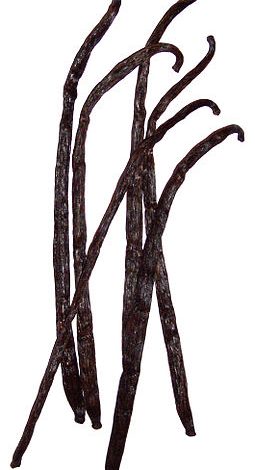Vanilla

Vanilla is a spice derived from orchids of the genus Vanilla, primarily obtained from pods of the Mexican species, flat-leaved vanilla (V. planifolia). The word vanilla, derived from vainilla, the diminutive of the Spanish word vaina (vaina itself meaning a sheath or a pod), is translated simply as “little pod”. Pre-Columbian Mesoamerican people cultivated the vine of the vanilla orchid, called tlīlxochitl by the Aztecs.
Pollination is required to make the plants produce the fruit from which the vanilla spice is obtained. In 1837, Belgian botanist Charles François Antoine Morren discovered this fact and pioneered a method of artificially pollinating the plant. The method proved financially unworkable and was not deployed commercially. In 1841, Edmond Albius, a 12-year-old slave who lived on the French island of Réunion in the Indian Ocean, discovered that the plant could be hand-pollinated. Hand-pollination allowed global cultivation of the plant. Noted French botanist and plant collector Jean Michel Claude Richard falsely claimed to have discovered the technique three or four years earlier. By the end of the 20th century, Albius was considered the true discoverer.
Three major species of vanilla currently are grown globally, all of which derive from a species originally found in Mesoamerica, including parts of modern-day Mexico. They are V. planifolia (syn. V. fragrans), grown on Madagascar, Réunion, and other tropical areas along the Indian Ocean; V. tahitensis, grown in the South Pacific; and V. pompona, found in the West Indies, Central America, and South America. The majority of the world’s vanilla is the V. planifolia species, more commonly known as Bourbon vanilla (after the former name of Réunion, Île Bourbon) or Madagascar vanilla, which is produced in Madagascar and neighboring islands in the southwestern Indian Ocean, and in Indonesia. Madagascar’s and Indonesia’s cultivations produce two-thirds of the world’s supply of vanilla.
Vanilla is the second-most expensive spice after saffron because growing the vanilla seed pods is labor-intensive. Nevertheless, vanilla is widely used in both commercial and domestic baking, perfume manufacture, and aromatherapy.
According to popular belief, the Totonac people, who live on the east coast of Mexico in the present-day state of Veracruz, were among the first people to cultivate vanilla, during the era of the Aztec Empire (around the 15th century).[1] Aztecs invading from the central highlands of Mexico conquered the Totonacs, and developed a taste for the vanilla pods. They named the fruit tlilxochitl, or “black flower”, after the matured fruit, which shrivels and turns black shortly after being picked. Spanish conquistador Hernán Cortés is credited with introducing both vanilla and chocolate to Europe in the 1520s.[2]
Until the mid-19th century, Mexico was the chief producer of vanilla.[3] In 1819, French entrepreneurs shipped vanilla fruits to the islands of Réunion and Mauritius in hopes of producing vanilla there. After 1841, when Edmond Albius discovered how to pollinate the flowers quickly by hand, the pods began to thrive. Soon, the tropical orchids were sent from Réunion to the Comoros Islands, Seychelles, and Madagascar, along with instructions for pollinating them. By 1898, Madagascar, Réunion, and the Comoros Islands produced 200 metric tons of vanilla beans, about 80% of world production in that year. According to the United Nations Food and Agriculture Organization 2019 data, Madagascar, followed by Indonesia, were the largest producers of vanilla in 2018.[4]
Vanilla cultivation
After a tropical cyclone ravaged key croplands, the market price of vanilla rose sharply in the late 1970s and remained high through the early 1980s despite the introduction of Indonesian vanilla. In the mid-1980s, the cartel that had controlled vanilla prices and distribution since its creation in 1930 disbanded.[5] Prices dropped 70% over the next few years, to nearly US$20 per kilogram; prices rose sharply again after tropical cyclone Hudah struck Madagascar in April 2000.[6] The cyclone, political instability, and poor weather in the third year drove vanilla prices to US$500/kg in 2004, bringing new countries into the vanilla industry. A good crop, coupled with decreased demand caused by the production of imitation vanilla, pushed the market price down to the $40/kg range in the middle of 2005. By 2010, prices were down to $20/kg. Cyclone Enawo caused a similar spike to $500/kg in 2017.[7]
